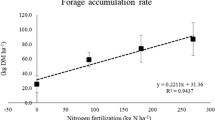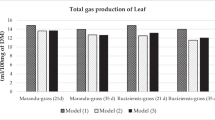Abstract
During the 1972 growing season, the productivity of a short form and a tall form ofSpartina alterniflora was studied by the harvest method in the vicinity of the Rutgers Marine Sciences Center on Great Bay near Tuckerton, New Jersey. The aboveground biomass of living and dead grass was determined and subsamples were analyzed for caloric equivalents, ash, nitrogen, crude protein, crude fiber, ether extract, and nitrogen free extract.
S. alterniflora had peak standing crops of 1,592 g/m2 for tall form and 592 g/m2 for short form. Standing crops of crude fiber, ether extract, nitrogen free extract, and caloric values are a function of dry matter production while nitrogen components seem to be influenced by some other factor. Seventy percent of the crude protein was present in early summer at a time when dry weight was less than 50% of its maximum value. The data indicate that the amount of nitrogen that the plant accumulates in its aboveground parts early in the growing season is directly related to the peak of dry matter standing crop. The early spring accumulation of nitrogen may act to offset shortages at the peak of the growing season. The chemical composition of litter and soil samples suggests that biological breakdown of plant material occurs at the soil surface.
Similar content being viewed by others
Literature Cited
ASSOCIATION of OFFICIAL AGRICULTURAL CHEMISTS. 1960. Official methods of analysis.Assoc. Offic. Agr. Chem.. Washington, D. C. 832 p.
BOYD, C. E. 1968. Freshwater plants: a potential source of protein.Econ. Bot. 23:359–370.
— 1970a. Amino acid, protein, and caloric content of vascular aquatic macrophytes.Ecology 51: 902–906.
— 1970b. Productivity, mineral accumulation, and pigment concentrations inTypha latifolia andScirpus americanus.Ecology 51:285–290.
— 1971. The dynamics of dry matter and chemical substances in aJuncus effusus population.Amer. Midl. Nat. 86:28–45.
— and L. W. HESS. 1970. Factors influencing shoot production and mineral nutrient levels inTypha latifolia.Ecology 51:296–300.
BURKHOLDER, P. R. 1956. Studies in the nutritive value ofSpartina grass growing in the marsh area of coastal Georgia.Bull Torrey Bot. Club 83:327–334.
—, and G. H. BORNSIDE. 1957. Decomposition of marsh grass by aerobic marine bacteria.Bull. Torrey Bot. Club 84:366:383.
BUTTERY, R. F., and J. H. EHRENREICH. 1961. Nutritive quality of little bluestem in the Missouri Ozarks. U.S.D.A. Forest Service,Cent. States Forest Exp. Sta. Tech. Paper 179.
CUMMINS, K. W. 1967. Caloric equivalents for studies in ecological energetics. Pymatuning Laboratory of Ecology, U. of Pittsburgh. 2nd edition. 52 p.
CUSMANO, I., and G. SCOTTON. 1951. Determination of crude fiber in feeds.Riv. di Zootec. 24:18–19.
DARNELL, R. M. 1967. Organic detritus in relation to the estuarine ecosystem, p. 376–382.In G. H. Lauff, (ed.), Estuaries, A. A. A. S. No. 83.
DURAND, J. B., and R. J. NADEAU, 1972. Water resources development in the Mullica River Basin. Part I. Biological evaluation of the Mullica River-Great Bay Estuary, N. J. Water Resources Res. Inst., Rutgers University. 138p.
HADLEY, E. B., and L. C. BLISS. 1964. Energy relationships in alpine plants on Mt. Washington, New Hampshire.Ecol. Monogr. 34:331–357.
HALL, K. J., W. C. WEMIER and G. F. LEE. 1970. Amino acids in an estuarine environment.Limnol. Oceanogr. 15:162–164.
JERVIS, R. A. 1969. Primary production in the freshwater marsh ecosystem of Troy Meadows, New Jersey.Bull. Torrey Bot. Club 96:209–231.
KEEFE, C. W. 1972. Marsh, production: A summary of the literature.Marine Science 16:163–181.
KIECKHEFER, B. J. 1963. Correlation between phenology and caloric content in forest herbs.Trans. Ill. St. Acad. Sci. 55:215–223.
MILNER, C., and R. HUGHES. 1968. Primary production in grasslands. I. B. P. Handbook No. 6, Blackwell Scientific Publications Oxford and Edinburgh. 70 p.
MOONEY, H. A., and W. D. Billings 1960. The annual carbohydrate cycle of alpine plants as related to growth.Amer. Jour. Bot. 47(7):594–598.
NADEAU, R. J. 1972. Primary production and export of plant material in the salt marsh ecosystem. Ph. D. Thesis. Rutgers University, New Brunswick, New Jersey.
ODUM, E. P. 1971. Fundamentals of Ecology. 3rd edition. W. B. Saunders Company, Philadelphia. 574p.
ODUM, E. P., and A. A. de la CRUZ. 1967. Particulate organic detritus in a Georgia salt marsh-estuarine ecosystem, p. 383–388.In G. H. Lauff, (ed.), Estuaries. A. A. A. S. No. 83.
PARR INSTRUMENT COMPANY. 1968. Oxygen bomb calorimetry and combustion methods. Tech. Manual No. 130. Parr Inst. Co., Moline, Illinois. 56 p.
PENFOUND, W. T. 1956. Primary production of vascular aquatic plants.Limnol., Oceanogr. 1:92–101.
PHILLIPS, T. G., J. T. SULLIVAN, M. E. LOUGHLIN, and V. G. SPRAGUE 1954. Chemical composition of forage grasses. I. Changes with plant maturity.Agron. Jour. 46:361–369.
PLUMMER, B. E. JR. 1953. Chemical composition of grasses and legumes in Maine.Maine Agr. Exp. Sta. Bull. 513:1–29.
REIFSNYDER, W. E., and H. W. LULL. 1965. Radiant energy in relation to forests.Tech. Bull. No. 1344.U. S. D. A., Forest Service, 111p.
REINERS, W. A., and N. M. REINERS. 1972. Comparison of oxygen-bomb combustion with standard ignition techniques for determining total ash.Ecology 53:134–136.
TALLING, J. F. 1961. Photosynthesis under natural conditions.Ann. Rev. Plant Physiol. 12:133–154.
TEAL, J. M. 1962. Energy flow in the salt marsh ecosystem of Georgia.Ecology 43:614–624.
UDELL, H. F., J. ZARUDSKY, T. E. DOHENY, and P. R. BURKHOLDER. 1969. Productivity and nutrient values of plants growing in the salt marshes of the town of Hempstead, Long Island.Bull. Torrey Bot. Club 96:42–51.
VALIELA, I., and J. TEAL. 1971. Nutrient and sewage enrichment experiments in a salt marsh ecosystem. A. A. A. S. meetings, Philadelphia, Pa.A. A. A. S. Misc. Publ. 71-72.
VAN RIPER, G. E., and D. SMITH. 1959. Changes in chemical composition of the herbage of alfalfa, medium red clover, ladino clover, and brome grass with advance in maturity. Wisc. Agr. Exp. Sta., Madison Wisconsin Research Dept.
VICKERY, H. B., G. W. PUCHER, A. J. WAKEMAN, and C. S. LEVENWORTH. 1946. Chemical investigation of the metabolism of plants. I. The nitrogen nutrition ofNarcissus poeticus. Conn. Agr. Exp. Sta. Bull. No. 496. 93p.
WEAVER, J. E. 1954. North American Prairie. Johnsen Publishing Co., Lincoln, Nebraska. 348p.
WESTLAKE, D. F. 1963. Comparisons of plant productivity.Biol. Rev. 38:385–425.
—, 1966. The biomass and productivity ofGlyceria maxima. I. Seasonal changes in biomass.J. Ecol. 54:745–753.
Author information
Authors and Affiliations
Rights and permissions
About this article
Cite this article
Squiers, E.R., Good, R.E. Seasonal changes in the productivity, caloric content, and chemical composition of a population of salt-marsh cord-grass (Spartina alterniflora). Chesapeake Science 15, 63–71 (1974). https://doi.org/10.2307/1351263
Issue Date:
DOI: https://doi.org/10.2307/1351263




